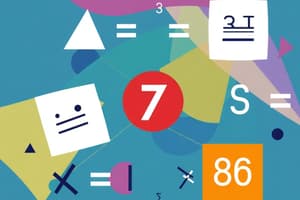Podcast
Questions and Answers
ความน่าจะเป็นของเหตุการณ์คืออะไร?
ความน่าจะเป็นของเหตุการณ์คืออะไร?
- จำนวนผลลัพธ์ที่ไม่เป็นประโยชน์หารด้วยผลลัพธ์รวมทั้งหมด
- จำนวนนับรวมทั้งหมดในเหตุการณ์
- จำนวนนับของผลลัพธ์ที่เป็นประโยชน์หารด้วยผลลัพธ์รวมทั้งหมด (correct)
- ผลลัพธ์ที่เกิดขึ้นทั้งหมดในการทดลอง
ในรูปสามเหลี่ยมมุมฉาก, สูตรใดที่ใช้ในการหาความสัมพันธ์ระหว่างด้าน?
ในรูปสามเหลี่ยมมุมฉาก, สูตรใดที่ใช้ในการหาความสัมพันธ์ระหว่างด้าน?
- สูตรการคูณทั่วไป: $a*b = c$
- สูตรของลอการิธึม: $log_b(a) = c$
- สูตรพีทาโกรัส: $a^2 + b^2 = c^2$ (correct)
- สูตรของฟิโบนัชชี: $F(n) = F(n-1) + F(n-2)$
หลักการใดในคณิตศาสตร์ที่กล่าวว่าตัวเลขทุกตัวที่มากกว่าหนึ่งสามารถแสดงได้โดยเฉพาะเป็นผลคูณของตัวประกอบเฉพาะ?
หลักการใดในคณิตศาสตร์ที่กล่าวว่าตัวเลขทุกตัวที่มากกว่าหนึ่งสามารถแสดงได้โดยเฉพาะเป็นผลคูณของตัวประกอบเฉพาะ?
- หลักการพื้นฐานของเลขจำนวน (correct)
- ทฤษฎีบทของพีทาโกรัส
- ทฤษฎีบทของไบนอมีนัล
- ทฤษฎีสัมพันธ์ของจำนวนคู่
ทฤษฎีบทใดที่ให้สูตรสำหรับการขยาย $(a + b)^n$?
ทฤษฎีบทใดที่ให้สูตรสำหรับการขยาย $(a + b)^n$?
กลยุทธ์ใดที่ดีที่สุดในการพัฒนาทักษะคณิตศาสตร์?
กลยุทธ์ใดที่ดีที่สุดในการพัฒนาทักษะคณิตศาสตร์?
จำนวนใดบ้างที่เป็นจำนวนเชิงตรรกะ (Rational Numbers)?
จำนวนใดบ้างที่เป็นจำนวนเชิงตรรกะ (Rational Numbers)?
พื้นที่ของรูปสี่เหลี่ยมผืนผ้าคำนวณได้จากสูตรใด?
พื้นที่ของรูปสี่เหลี่ยมผืนผ้าคำนวณได้จากสูตรใด?
การหาค่าลิมิต (Limits) ในแคลคูลัสหมายถึงอะไร?
การหาค่าลิมิต (Limits) ในแคลคูลัสหมายถึงอะไร?
สูตรสำหรับการหาความสูง (h) ของรูปสามเหลี่ยมมุมฉาก ในการใช้ฟังก์ชันไซน์ คืออะไร?
สูตรสำหรับการหาความสูง (h) ของรูปสามเหลี่ยมมุมฉาก ในการใช้ฟังก์ชันไซน์ คืออะไร?
ค่าเฉลี่ย (Mean) ของชุดข้อมูลคืออะไร?
ค่าเฉลี่ย (Mean) ของชุดข้อมูลคืออะไร?
Flashcards are hidden until you start studying
Study Notes
Basic Concepts
-
Numbers:
- Natural Numbers: Counting numbers (1, 2, 3, ...)
- Whole Numbers: Natural numbers + 0
- Integers: Whole numbers + negative numbers (-3, -2, -1, 0, 1, 2, 3)
- Rational Numbers: Numbers that can be expressed as fractions (e.g., 1/2, 3.0)
- Irrational Numbers: Numbers that cannot be expressed as fractions (e.g., √2, π)
-
Operations:
- Addition (+)
- Subtraction (−)
- Multiplication (×)
- Division (÷)
Algebra
- Variables: Symbols that represent numbers (e.g., x, y)
- Expressions: Combinations of numbers, variables, and operations (e.g., 3x + 2)
- Equations: Mathematical statements that two expressions are equal (e.g., 3x + 2 = 11)
- Factoring: Breaking down expressions into simpler components (e.g., x² - 9 = (x + 3)(x - 3))
Geometry
- Shapes:
- 2D: Circles, triangles, squares, rectangles
- 3D: Spheres, cubes, cylinders, cones
- Fundamental Properties:
- Area: Measure of space within a shape (e.g., A = l × w for rectangles)
- Perimeter: Distance around a shape (e.g., P = 2(l + w) for rectangles)
- Volume: Measure of space within a 3D object (e.g., V = l × w × h for cubes)
Trigonometry
- Functions:
- Sine (sin), Cosine (cos), Tangent (tan)
- Right Triangle Relationships:
- sin(θ) = opposite/hypotenuse
- cos(θ) = adjacent/hypotenuse
- tan(θ) = opposite/adjacent
Calculus
- Limits: Understand the behavior of functions as they approach a certain point.
- Derivatives: Measure the rate at which a quantity changes (e.g., slope of a curve).
- Integrals: Calculate the area under a curve or accumulation of quantities.
Statistics
- Descriptive Statistics:
- Mean: Average of data set
- Median: Middle value when data is sorted
- Mode: Most frequently occurring value
- Inferential Statistics: Making predictions or generalizations about a population based on a sample.
Probability
- Basic Concepts:
- Experiment: A process that leads to one or more outcomes.
- Event: A specific outcome or set of outcomes.
- Probability of an event: P(E) = number of favorable outcomes / total number of outcomes.
Key Mathematical Theorems
- Pythagorean Theorem: In a right triangle, a² + b² = c² (where c is the hypotenuse).
- Fundamental Theorem of Arithmetic: Every integer greater than 1 can be uniquely expressed as a product of prime numbers.
- Binomial Theorem: Provides a formula for the expansion of (a + b)ⁿ.
Tips for Success in Math
- Practice regularly: Consistency is key to grasping mathematical concepts.
- Understand the concepts: Focus on understanding the 'why' behind methods.
- Work on problem-solving: Practice a variety of problems to improve skills.
- Review mistakes: Analyze errors to learn and avoid them in the future.
แนวคิดพื้นฐาน
-
ตัวเลข:
- จำนวนธรรมชาติ: ตัวเลขที่ใช้ในการนับ (1, 2, 3,…)
- จำนวนเต็ม: จำนวนธรรมชาติรวม 0
- จำนวนเต็มที่รวมถึงจำนวนลบ: จำนวนทั้งสิ้น รวมถึงจำนวนลบ (-3, -2, -1, 0, 1, 2, 3)
- จำนวนมีเหตุผล: จำนวนที่สามารถเขียนเป็นเศษส่วน (เช่น 1/2, 3.0)
- จำนวนที่ไม่มีเหตุผล: จำนวนที่ไม่สามารถเป็นเศษส่วน (เช่น √2, π)
-
การดำเนินการ:
- การบวก (+)
- การลบ (−)
- การคูณ (×)
- การหาร (÷)
พีชคณิต
- ตัวแปร: สัญลักษณ์ที่แทนตัวเลข (เช่น x, y)
- นิพจน์: การรวมกันของตัวเลข, ตัวแปร และการดำเนินการ (เช่น 3x + 2)
- สมการ: คำกล่าวทางคณิตศาสตร์ที่แสดงว่าสองนิพจน์มีค่าเท่ากัน (เช่น 3x + 2 = 11)
- การหาค่ารวม: การแยกนิพจน์ให้เป็นส่วนที่ง่ายกว่า (เช่น x² - 9 = (x + 3)(x - 3))
รูปทรงเรขาคณิต
- รูปทรง:
- 2 มิติ: วงกลม, สามเหลี่ยม, สี่เหลี่ยมจัตุรัส, สี่เหลี่ยมผืนผ้า
- 3 มิติ: สุนัข, ลูกบาศก์, กระบอก, กรวย
- คุณสมบัติพื้นฐาน:
- พื้นที่: วัดขนาดภายในรูปทรง (เช่น A = l × w สำหรับสี่เหลี่ยมผืนผ้า)
- เส้นรอบรูป: ระยะทางรอบรูปทรง (เช่น P = 2(l + w) สำหรับสี่เหลี่ยมผืนผ้า)
- ปริมาตร: วัดขนาดภายในวัตถุ 3D (เช่น V = l × w × h สำหรับลูกบาศก์)
ตรีโกณมิติ
- ฟังก์ชัน:
- ไซน์ (sin), โคไซน์ (cos), แทนเจนต์ (tan)
- ความสัมพันธ์ในสามเหลี่ยมมุมฉาก:
- sin(θ) = ด้านตรงข้าม/ด้านทแยง
- cos(θ) = ด้านข้าง/ด้านทแยง
- tan(θ) = ด้านตรงข้าม/ด้านข้าง
แคลคูลัส
- ขีดจำกัด: เข้าใจพฤติกรรมของฟังก์ชันเมื่อเข้าใกล้จุดหนึ่ง
- อนุพันธ์: วัดอัตราที่ปริมาณเปลี่ยนแปลง (เช่น ความชันของเส้นโค้ง)
- ปริอินทรีย์: คำนวณพื้นที่ใต้เส้นโค้งหรือการสะสมของปริมาณ
สถิติ
- สถิติพรรณนา:
- ค่าเฉลี่ย: ค่าเฉลี่ยของชุดข้อมูล
- มัธยฐาน: ค่ากลางเมื่อข้อมูลถูกจัดเรียง
- ฐานนิยม: ค่าที่เกิดขึ้นบ่อยที่สุด
- สถิติอนุมาน: การทำการคาดการณ์หรือการทั่วไปเกี่ยวกับประชากรจากตัวอย่าง
ความน่าจะเป็น
- แนวคิดพื้นฐาน:
- การทดลอง: กระบวนการที่นำไปสู่ผลลัพธ์หนึ่งหรือมากกว่า
- เหตุการณ์: ผลลัพธ์เฉพาะหรือชุดของผลลัพธ์
- ความน่าจะเป็นของเหตุการณ์: P(E) = จำนวนผลลัพธ์ที่เหมาะสม / จำนวนผลลัพธ์ทั้งหมด
ทฤษฎีทางคณิตศาสตร์ที่สำคัญ
- ทฤษฎีบทพีทาโกรัส: ในสามเหลี่ยมมุมฉาก, a² + b² = c² (โดยที่ c คือด้านทแยง)
- ทฤษฎีบทพื้นฐานของเลขจำนวน: จำนวนเต็มที่มากกว่า 1 สามารถแสดงเป็นผลิตภัณฑ์ของจำนวนที่เป็นปัจจัยเฉพาะได้อย่างมีเอกลักษณ์
- ทฤษฎีบทแบบไบโนเมียล: ให้สูตรสำหรับการขยายของ (a + b)ⁿ
เคล็ดลับสำหรับความสำเร็จในคณิตศาสตร์
- ฝึกฝนอย่างสม่ำเสมอ: ความสม่ำเสมอคือกุญแจสู่การเข้าใจแนวคิดทางคณิตศาสตร์
- เข้าใจแนวคิด: มุ่งเน้นการเข้าใจ 'ทำไม' เบื้องหลังวิธีการต่าง ๆ
- ฝึกทักษะการแก้ปัญหา: ฝึกทำปัญหาหลายประเภทเพื่อพัฒนาทักษะ
- ตรวจสอบข้อผิดพลาด: วิเคราะห์ข้อผิดพลาดเพื่อลงเรียนรู้และหลีกเลี่ยงในอนาคต
Studying That Suits You
Use AI to generate personalized quizzes and flashcards to suit your learning preferences.




